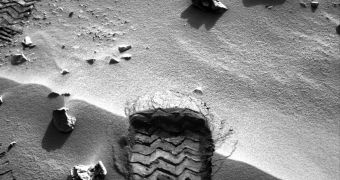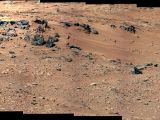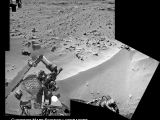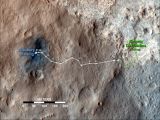The Curiosity Rover has been on Mars for two whole months now. Since then, it's been testing the equipment and has started moving towards its first big target inside the Gale Crater. In fact, it's now very close to it, Curiosity only has less than 200m to go before reaching its destination.
But it's not in any hurry to get there; it's taking the scenic route and stopping to check out all the sights. The most recent tourist spot on its trip is the “Rocknest.”
Scientists like to keep things simple, so the name does actually mean that there are a bunch of rocks around the location, sticking out of the sand.
But it's not the rocks that Curiosity is interested in, it's the sand itself. Part science experiment part instrument testing, Curiosity is getting ready to take its first scoop of sand and analyze it with its internal laboratory.
The NASA team has been looking for a good location to test the scoop; it needed soft sand to do it. It stumbled upon just such a location at Rocknest earlier this week.
To check whether the sand was indeed soft enough for scooping, Curiosity did something you and I might to do, it tested it with its feet (wheels).
It simply ran over a small sand dune with one of its wheels and then backed down. The imprint it left on the sand confirmed that it was soft enough.
Next, Curiosity will actually scoop some sand and run it through its complex CHIMRA (Collection and Handling for Interior Martian Rock Analysis) system.
"We now have reached an important phase that will get the first solid samples into the analytical instruments in about two weeks," Mission Manager Michael Watkins of NASA's Jet Propulsion Laboratory (JPL) said.
Curiosity will do this three times, but the sand will reach the analysis chamber only the last time. CHIMRA must first be cleansed of any contaminants that may be left from Earth, the trip to Mars or even the trip to the current location.
On the third try, a portion of the sand scooped up will be directed to CheMin, the chemistry and mineralogy instrument aboard Curiosity which will be used to determine the nature of the minerals in the sample.
A fourth scoop will direct will also send a portion to the "sample analysis on Mars" (SAM) instrument, which is used to identify chemical elements. SAM consists of three different instruments, a gas chromatograph, a quadrupole mass spectrometer and a laser spectrometer.
All of this will take about two weeks, during which time Curiosity will remain at the Rocknest location.
The results from the analysis will be available at that time, but scientists don't expect to find anything spectacular at this time. This experiment is more about testing Curiosity's systems than scientific discoveries.
After that, Curiosity will travel about 100m towards another area where it will get to use its drill for the first time to "look" inside a rock.
Curiosity's been on Mars for 60 Sols (Martian days) now and it's been on the move for 50 Sols. In that time it covered about 500m, 484m if you want to be exact. It's still got some 176m to travel to its next big destination, Glenelg.

 14 DAY TRIAL //
14 DAY TRIAL // 


